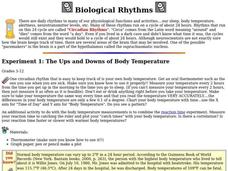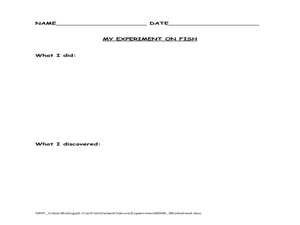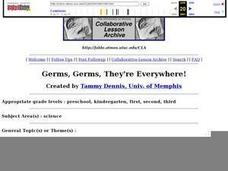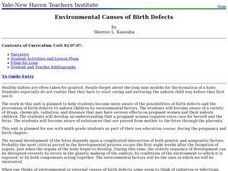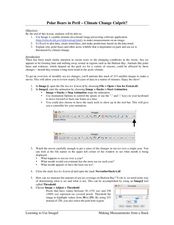Curated OER
Using an Observation Log to enhance studies in biology
Young scholars choose a subject or setting that be suitable for them to observe for the entire school year. They are encouraged to pick a site that they have ready access to and that they believe be interested in.
Curated OER
Biology Research Assignment
Students become aware of and develop an appreciation for science in the world around us.
Curated OER
Biology Assignment on Sex determination
Students use this activity prior to the introduction of materials on Genetics. They read the article "Becoming a Male, Becoming a Female" in the publication From Egg to Adult. Students then complete the assignment in order to better...
Curated OER
Field Biology
Students work with 4th and 5th graders at Cascade Brook School in Farmington, to teach them skills in wildflower and fern identification, and then to help them implement a nature trail, which is accessible to the greater Farmington...
Curated OER
Biological Rhythms
Students conduct experiments to determine their circadian rhythms for a cycle of about 24 hours.
Curated OER
Adaptation and Mimicry - Biology
Students compare and contrast adaptations involving camouflage, warning coloration, and mimicry. They explain the relationship between adaptation and ability for survival and reproduction. Students define Batesian and Mullerian mimicry...
Curated OER
TAKS Biology Review
Students review some TAKS objectives in life science preparing for the upcoming TAKS test. They are given their TAKS review workbook, students look at objectives 1 and 2 in the workbook. Students review and ask questions about the...
Curated OER
What Does Plant Biology Teach Is About Climate?
Students examine what factors influence climate. In this investigative instructional activity students compare the factors that influence climate and how they effect tree growth.
Curated OER
Bivalve Biology
Young scholars place clams into a beaker containing saltwater. They place a small drop of food coloring just above the shell. Students observe the movement of the food coloring. Clams are then placed into clean beakers of saltwater with...
Curated OER
Urban Biology: Can Fish Detect Odors
Learners investigate how fish use their sense of smell. In this scientific method lesson, students design and perform an experiment to investigate how fish use their sense of smell. This lesson includes statistical analysis and...
Pearson
Transcription
Teach young biologists the language of life with this series of worksheets on DNA. By working through these pages, students expand their understanding of genetics as they learn about the process of transcription and the...
Curated OER
Germs, Germs, They're Everywhere!
Youngsters recognize that germs are everywhere, and can make us sick. They identify ways that germs can be spread, see how they can prevent the spreading of germs, and learn appropriate hand washing techniques.
Curated OER
Environmental Causes of Birth Defects
Get your high schoolers thinking about the factors that lead to birth defects. They examine how environmental factors and personal choices can cause birth defects in unborn children. They discover the effects of various handicaps such as...
Curated OER
Investigative Case - "Rio Grande Wildlife Refuge"
Learners study wildlife management as it relates to ecological principles and whole systems. They role play professional ecologists working for the fish and wildlife service to develop a plan to manage a new wildlife refuge along the Rio...
Curated OER
Life Systems- Zoo Central
Students investigate the various aspects associated with living things while also concentrating on their basic needs. They explore the aspects of movement and growth in plants and animals. This is done through research and other...
Curated OER
Investigate Science Using Crayfish
Young scientists discover the importance of scientific investigation by observing live crayfish. They carefully observe the patterns of crayfish in different environments. Then they discuss their conclusions and define what all living...
Curated OER
Women in Science: Dr. Grace Bush
Learn about the study of paleoecology with a resource about Dr. Grace Bush and her contributions to the field. After reading a one-page passage, learners answer comprehension questions and explore their personal interests in different...
Biology Junction
Cells and Their Organelles
This series of handouts and images asks young scientists to read short informational paragraphs, answer identification questions, and color and label diagrams of animal and plant cells. This is a complete resource that could be given as...
Curated OER
Identifying Ozone Variations over Different Locations
Students analyze ozone data. For this atmosphere lesson, students will use a NASA resource to gather data for different regions of the Earth. Students will then create a graph for their data and answer related questions.
Curated OER
The Human-Animal Bond
Youngsters read about the bond between some animals and humans and how animals help us out. Unusual examples are given: honey-guide birds, dolphins that shepherd fish for fishermen, landmine-locating rats, and piranhas that give...
Curated OER
AP: Chapter 45: Chemical Regulation & Communication - Hormones and the Endocrine System
Infuse your AP biologists with the details of the endocrine system. This six-page worksheet queries learners thoroughly about gland structure and hormone function. Ms. Foglia, the author, has not left anything out of this resource,...
Curated OER
Introduction to Watsonville Wetlands
Identify the different plants and animals found in wetlands, your class will explain the importance of wetland ecosystem and locate the different wetlands in their area.
Curated OER
Evidence of Evolution by Natural Selection
Walk your junior biologists through the evidence that supports evolution. The fossil record, anatomical record, and molecular record are explained and supported by colorful graphs and pictures. Extensive notes are provided for some of...
Curated OER
Polar Bears in Peril - Climate Change Culprit?
Students explore the changes in sea ice over several years. In this life science lesson plan, students review and examine 20 years of data. They use Excel to graph data and analyze trends.




